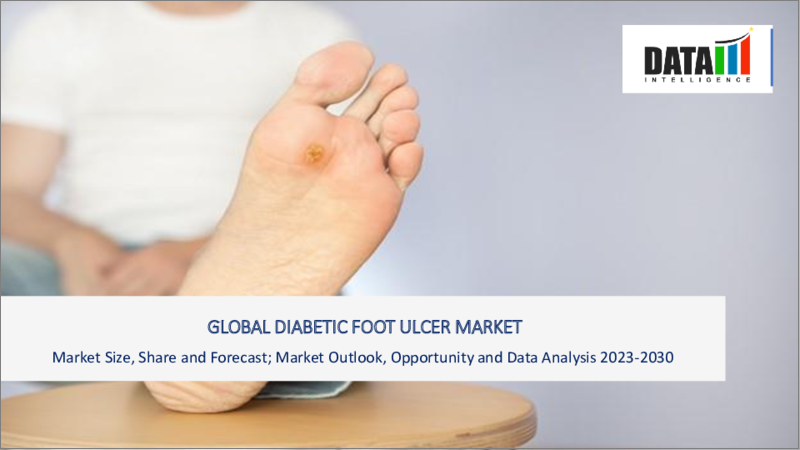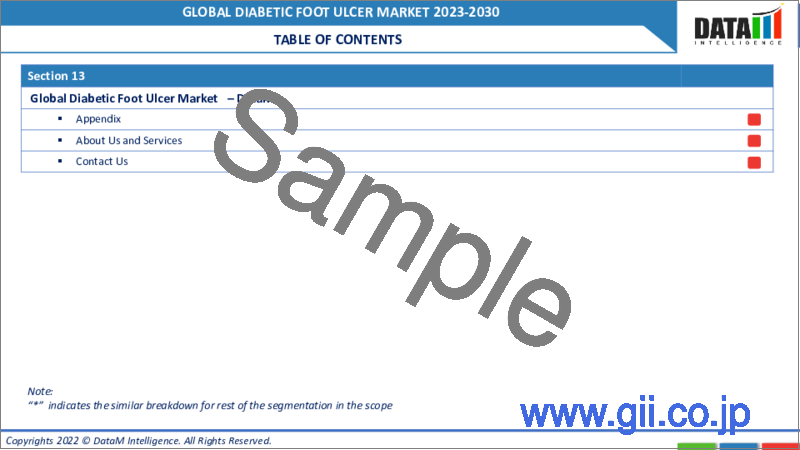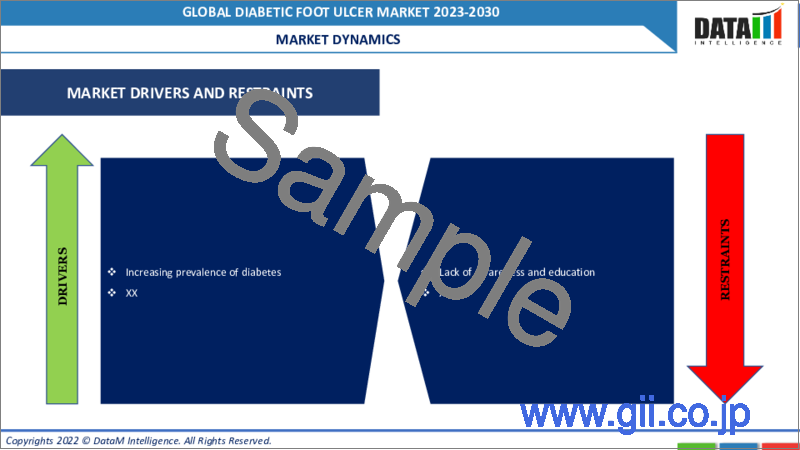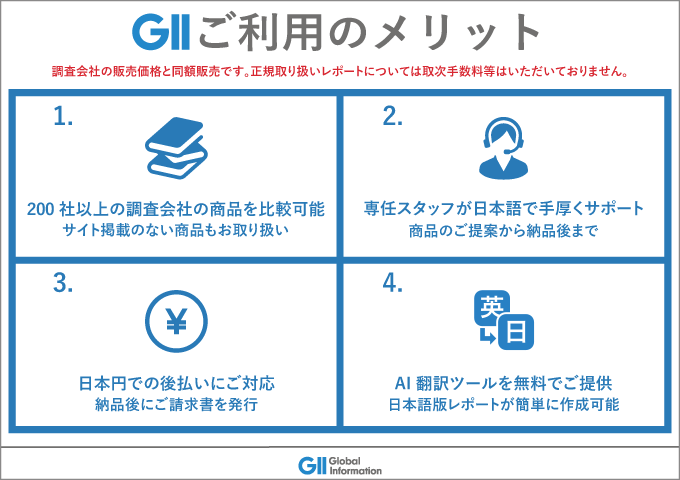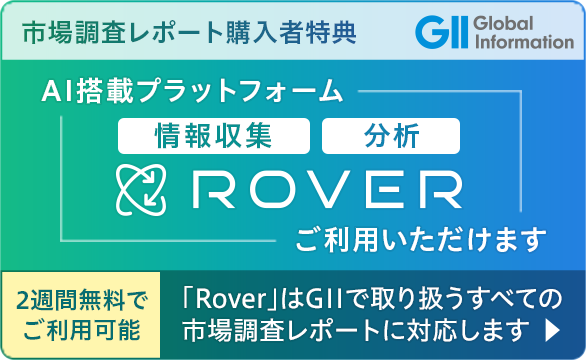|
|
市場調査レポート
商品コード
1279711
糖尿病性足潰瘍の世界市場- 2023-2030年Global Diabetic Foot Ulcer Market - 2023-2030 |
||||||
|
● お客様のご希望に応じて、既存データの加工や未掲載情報(例:国別セグメント)の追加などの対応が可能です。 詳細はお問い合わせください。 |
|||||||
| 糖尿病性足潰瘍の世界市場- 2023-2030年 |
|
出版日: 2023年05月26日
発行: DataM Intelligence
ページ情報: 英文 195 Pages
納期: 即日から翌営業日
|
- 全表示
- 概要
- 目次
市場概要
世界の糖尿病性足潰瘍市場は、2022年に58億1,270万米ドルに達し、2030年には93億60万米ドルに達するなど、有利な成長が予測されます。糖尿病性足潰瘍市場は、予測期間中(2023年~2030年)に6.2%のCAGRで成長すると予測されます。糖尿病性足潰瘍は、糖尿病の管理が不十分な人に最も多く見られる結果の1つです。不十分な血糖管理、基礎的な神経障害、末梢血管疾患、または不十分なフットケアが、糖尿病性足潰瘍の一般的な原因です。
糖尿病性足潰瘍は、体の創傷治癒能力が著しく低下しているため、糖尿病患者が直面する最も深刻な事態の一つです。一般的に患者の足に傷ができ、その傷はすぐに腐敗し、その特定の場所で感染性の細菌を発生させることになります。
市場力学
糖尿病性足潰瘍の有病率の増加
糖尿病がもたらす最も深刻で深刻な結果のひとつが糖尿病性足潰瘍です。糖尿病の有病率が高まるにつれて、問題の数も増えています。糖尿病性足潰瘍の発生を増加させる要因として、年齢の上昇、座りがちなライフスタイル、糖尿病罹患期間の長期化など、さまざまな要因が挙げられます。
治療法の技術的進歩
最新の携帯電話では、市販のデジタルカメラと同等の高解像度のDFU画像を撮影することができます。現在、多くの患者が携帯電話の写真を使ってDFUを自己管理しています。また、DFU治療のフォローアップのために、フットクリニックに写真を持参し、傷の経過を定期的に観察している患者さんもいます。
また、患者がフットケアプロバイダーにオンラインまたは電子メールの添付ファイルとして画像を送ることもあります。このような臨床情報を守秘義務に違反することなく安全に共有することは、現在のところ困難であるが、DFUの進展の自己モニタリングに携帯電話の写真を広く使用することは、将来のフットケアを変えるかもしれないです。
糖尿病性足潰瘍の治療には高額な費用がかかる
糖尿病性足潰瘍は、創傷被覆材、薬剤、頻繁なモニタリングなど、長期的かつ集中的な治療が必要な場合があります。この治療期間の長期化は、治療費の増加につながる可能性があります。糖尿病性足潰瘍の治療には、足病医、創傷治療専門医、内分泌専門医、血管外科医など、複数のヘルスケア専門家を含む集学的アプローチが必要となることが多いです。様々な医療従事者の間でケアを調整することで、総費用が増加する可能性があります。
COVID-19の影響分析
COVID-19の大流行は、世界中でDFU治療に大きな支障をきたしました。潰瘍の評価の遅れは、DFUの治癒に悪影響を及ぼし、切断につながる可能性があります。
パンデミックの間、電話やビデオクリニックは、COVID-19の封鎖期間中に患者が医療クリニックに通えないことに関連する懸念のいくつかに対処するために医師を支援しました。科学界では、バーチャルクリニックを通じて患者のケアを向上させる人工知能(AI)アルゴリズムを構築する試みが、流行に呼応するように支持されました。
ロシアとウクライナのコンフリクト分析
ウクライナでは、ヘルスケアサービスへのアクセスが不十分なため、何千人もの人々が糖尿病性足潰瘍に苦しみ、その結果、下肢切断の大きなリスクにさらされています。慢性潰瘍と切断に関連するハンディキャップに対処しなければ、ウクライナの個人と公衆の健康が損なわれる可能性があります。
プライマリーケアとリモートケアの強化、セルフケアに関する個人の指導、糖尿病性足部治療のための適切な用品の提供は、切断、障害、死亡率を大幅に減少させる可能性を秘めています。ウクライナやその他の紛争地域で十分な糖尿病フットケアを行うことは、地域住民の健康や被災国が危機後に回復するために不可欠です。
目次
第1章 調査手法と範囲
- 調査手法
- 調査目的および調査範囲
第2章 定義と概要
第3章 エグゼクティブサマリー
- 製品タイプ別スニペット
- 潰瘍の種類別スニペット
- エンドユーザー別スニペット
- 地域別スニペット
第4章 市場力学
- 影響要因
- 促進要因
- 糖尿病性足潰瘍の有病率の増加
- 抑制要因
- 糖尿病性足潰瘍の治療費の高さ
- 機会
- 治療オプションの技術的進歩
- 影響分析
- 促進要因
第5章 産業分析
- ポーターのファイブフォース分析
- サプライチェーン分析
- 価格分析
- 法規制の分析
第6章 COVID-19の分析
- COVID-19の分析
- COVID-19の前のシナリオ
- COVID-19期間中のシナリオ
- COVID-19後のシナリオ、または将来のシナリオ
- COVID-19の中での価格・ダイナミクス
- 需給スペクトル
- パンデミック時の市場に関連する政府の取り組み
- メーカーの戦略的な取り組み
- サマリー
第7章 製品タイプ別
- 創傷治療用ドレッシング
- バイオロジクス
- その他
第8章 潰瘍タイプ別
- 神経障害性潰瘍
- 神経・虚血性潰瘍
第9章 エンドユーザー別
- 病院
- 診療所
- 外来手術センター
- 在宅医療
第10章 地域別
- 北米
- 米国
- カナダ
- メキシコ
- 欧州
- ドイツ
- 英国
- フランス
- イタリア
- スペイン
- その他欧州
- 南米
- ブラジル
- アルゼンチン
- その他南米地域
- アジア太平洋地域
- 中国
- インド
- 日本
- オーストラリア
- その他アジア太平洋地域
- 中東・アフリカ地域
第11章 競合情勢
- 競合シナリオ
- 市況/シェア分析
- M&A(合併・買収)分析
第12章 企業プロファイル
- ConvaTec Inc
- Acelity LP Inc
- 3M Healthcare
- Organogenesis Inc
- Coloplast Corp
- Smith & Nephew Plc
- B Braun Melsungen AG
- Medline Industries Inc
- Medtronic
- Molnlycke Healthcare AB
第13章 付録
Market Overview
The global diabetic foot ulcers market reached US$ 5,812.7 million in 2022 and is projected to witness lucrative growth by reaching up to US$ 9,300.6 million by 2030. The diabetic foot ulcers market is expected to exhibit a CAGR of 6.2% during the forecast period (2023-2030). Diabetic foot ulcers are one of the most prevalent consequences in persons with poorly managed diabetes mellitus. Inadequate glycemic management, underlying neuropathy, peripheral vascular disease, or inadequate foot care are common causes of diabetic foot ulcers.
Diabetic foot ulcers are one of the most serious consequences that diabetics confront since the body's wound healing capacity has been greatly diminished. It is the creation of a wound, generally in the patient's foot, which decomposes quickly and leads to the generation of infectious germs in that specific location.
Market Dynamics
Increase in the Prevalence Of Diabetic Foot Ulcers
One of the most serious and severe consequences of diabetes is diabetic foot ulcer. As the prevalence of disease increases, so do the number of problems. Various variables, including rising age, sedentary lifestyle, and longer duration of diabetes mellitus, have all contributed to an increase in the occurrence of diabetic foot ulcers.
Technological Advancements In Treatment Options
Newer mobile phones can take high-resolution DFU images that are equivalent to those taken by commercial digital cameras. Many patients currently self-monitor their DFUs using cell phone photographs. Some patients painstakingly bring these photographs to foot clinics throughout their follow-up appointments for DFU therapy to serially track their wound development.
Patients occasionally send images to footcare providers online or as email attachments. Although the safety difficulties associated with the secure sharing of such clinical information without breaching confidentiality are currently hard, the widespread use of mobile phone photography for self-monitoring of DFU development may transform future foot care.
High Cost For Treatment Of Diabetic Foot Ulcers
Diabetic foot ulcers may need long-term and intense treatment, such as wound dressings, medicines, and frequent monitoring. This prolonged duration may lead to increased treatment expenses. Diabetic foot ulcer treatment often entails a multidisciplinary approach including several healthcare experts such as podiatrists, wound care specialists, endocrinologists, and vascular surgeons. Coordination of care among various providers may increase total costs.
COVID-19 Impact Analysis
The COVID-19 pandemic caused significant hurdles in DFU treatment over the world. Delays in ulcer evaluations may have a negative impact on DFU healing, potentially leading to amputations.
During the pandemic, telephone and video clinics assisted physicians in addressing some of the concerns connected to patients' incapacity to attend medical clinics during the COVID-19 lock-down period. Attempts by the scientific community to build artificial intelligence (AI) algorithms to improve patient care through virtual clinics gained traction in response to the epidemic.
Russia- Ukraine Conflcit Analysis
Due to the country's inadequate access to healthcare services, thousands of individuals in Ukraine suffer from diabetic foot ulcers and are consequently at significant risk of lower limb amputation. Individual and public health in Ukraine may suffer if the handicap associated with chronic ulcers and amputations is not addressed.
Strengthening primary and remote care, teaching individuals on self-care, and providing appropriate supplies for diabetic foot treatment have the potential to significantly reduce amputations, disability, and mortality. Adequate diabetic foot care in Ukraine and other conflict-torn regions is critical for the health of the local population and the ability of affected countries to recover after the crisis.
Segment Analysis
The Neuropathic Segment Is Expected To Have The Market Share Of Around 46.5% Over The Forecast Period.
Neuropathic ulcers are the most prevalent form of ulcer encountered in patients. As a result, this sector is dominated in the market in this category. This kind of disease is the most difficult to manage since it causes significant pain and agony to the individual; as a result, the usage of medications increases, helping to raise the revenue return for the diabetic foot ulcer treatment market.
Neuropathic ulcers arise when a patient with impaired peripheral nervous system neurological function has pressure sites that induce ulceration via the epidermal and dermal tissue layers. This is a frequent ailment that affects the foot and occasionally other sections of the body.
Geographical Analysis
North America is Expected to be the Dominating Region During The Forecast Period.
The North America region holds the largest share of the global diabetic foot ulcers market accounting for around 37.7% in the forecast period. This is owing the large number of diabetic patients and adequate healthcare facilities in this region. Also, North America also has lengthy R&D facilities and approval periods. The country also contains cutting-edge biologics and wound care equipments for the treatment of these ulcers.
Competitive Landscape
The major global players include: ConvaTec Inc, Acelity LP Inc, 3M Healthcare, Organogenesis Inc, Coloplast Corp Smith & Nephew Plc, B Braun Melsungen AG Medline Industries Inc, Medtronic, Molnlycke Healthcare AB and others.
- Why Purchase the Report?
- To visualize the global diabetic foot ulcers market segmentation based on the product type, ulcer type, end user and region, as well as understand key commercial assets and players.
- Identify commercial opportunities by analyzing trends and co-development.
- Excel data sheet with numerous data points of global diabetic foot ulcers market level with all segments.
- PDF report consists of a comprehensive analysis after exhaustive qualitative interviews and an in-depth study.
- Product mapping available as Excel consisting of key products of all the major players.
The global diabetic foot ulcers market report would provide approximately 92 tables, 108 figures and 195 Pages.
Target Audience 2023
- Manufacturers/ Buyers
- Industry Investors/Investment Bankers
- Research Professionals
- Emerging Companies
Table of Contents
1. Methodology and Scope
- 1.1. Research Methodology
- 1.2. Research Objective and Scope of the Report
2. Definition and Overview
3. Executive Summary
- 3.1. Snippet by Product Type
- 3.2. Snippet by Ulcer Type
- 3.3. Snippet by End User
- 3.4. Snippet by Region
4. Dynamics
- 4.1. Impacting Factors
- 4.1.1. Drivers
- 4.1.1.1. Increased prevalence of diabetic foot ulcers
- 4.1.2. Restraints
- 4.1.2.1. High cost of treatment for Diabetic foot ulcers
- 4.1.3. Opportunity
- 4.1.3.1. Technological advancements in treatment options
- 4.1.4. Impact Analysis
- 4.1.1. Drivers
5. Industry Analysis
- 5.1. Porter's Five Forces Analysis
- 5.2. Supply Chain Analysis
- 5.3. Pricing Analysis
- 5.4. Regulatory Analysis
6. COVID-19 Analysis
- 6.1. Analysis of COVID-19
- 6.1.1. Scenario Before COVID-19
- 6.1.2. Scenario During COVID-19
- 6.1.3. Post COVID-19 or Future Scenario
- 6.2. Pricing Dynamics Amid COVID-19
- 6.3. Demand-Supply Spectrum
- 6.4. Government Initiatives Related to the Market During Pandemic
- 6.5. Manufacturers Strategic Initiatives
- 6.6. Conclusion
7. By Product Type
- 7.1. Wound Care Dressing
- 7.2. Biologics
- 7.3. Others
8. By Ulcer Type
- 8.1. Neuropathic Ulcers
- 8.2. Neuro-Ischemic Ulcers
9. By End User
- 9.1. Hospitals
- 9.2. Clinics
- 9.3. Ambulatory Surgical Center
- 9.4. Homecare Setting
10. By Region
- 10.1. Introduction
- 10.1.1. Market Size Analysis and Y-o-Y Growth Analysis (%), By Region
- 10.1.2. Market Attractiveness Index, By Region
- 10.2. North America
- 10.2.1. Introduction
- 10.2.2. Key Region-Specific Dynamics
- 10.2.3. Market Size Analysis and Y-o-Y Growth Analysis (%), By Product Type
- 10.2.4. Market Size Analysis and Y-o-Y Growth Analysis (%), By Ulcer Type
- 10.2.5. Market Size Analysis and Y-o-Y Growth Analysis (%), By End User
- 10.2.6. Market Size Analysis and Y-o-Y Growth Analysis (%), By Country
- 10.2.6.1. The U.S.
- 10.2.6.2. Canada
- 10.2.6.3. Mexico
- 10.3. Europe
- 10.3.1. Introduction
- 10.3.2. Key Region-Specific Dynamics
- 10.3.3. Market Size Analysis and Y-o-Y Growth Analysis (%), By Product Type
- 10.3.4. Market Size Analysis and Y-o-Y Growth Analysis (%), By Ulcer Type
- 10.3.5. Market Size Analysis and Y-o-Y Growth Analysis (%), By End User
- 10.3.6. Market Size Analysis and Y-o-Y Growth Analysis (%), By Country
- 10.3.6.1. Germany
- 10.3.6.2. The U.K.
- 10.3.6.3. France
- 10.3.6.4. Italy
- 10.3.6.5. Spain
- 10.3.6.6. Rest of Europe
- 10.4. South America
- 10.4.1. Introduction
- 10.4.2. Key Region-Specific Dynamics
- 10.4.3. Market Size Analysis and Y-o-Y Growth Analysis (%), By Product Type
- 10.4.4. Market Size Analysis and Y-o-Y Growth Analysis (%), By Ulcer Type
- 10.4.5. Market Size Analysis and Y-o-Y Growth Analysis (%), By End User
- 10.4.6. Market Size Analysis and Y-o-Y Growth Analysis (%), By Country
- 10.4.6.1. Brazil
- 10.4.6.2. Argentina
- 10.4.6.3. Rest of South America
- 10.5. Asia-Pacific
- 10.5.1. Introduction
- 10.5.2. Key Region-Specific Dynamics
- 10.5.3. Market Size Analysis and Y-o-Y Growth Analysis (%), By Product Type
- 10.5.4. Market Size Analysis and Y-o-Y Growth Analysis (%), By Ulcer Type
- 10.5.5. Market Size Analysis and Y-o-Y Growth Analysis (%), By End user
- 10.5.6. Market Size Analysis and Y-o-Y Growth Analysis (%), By Country
- 10.5.6.1. China
- 10.5.6.2. India
- 10.5.6.3. Japan
- 10.5.6.4. Australia
- 10.5.6.5. Rest of Asia-Pacific
- 10.6. Middle East and Africa
- 10.6.1. Introduction
- 10.6.2. Key Region-Specific Dynamics
- 10.6.3. Market Size Analysis and Y-o-Y Growth Analysis (%), By Product Type
- 10.6.4. Market Size Analysis and Y-o-Y Growth Analysis (%), By Ulcer Type
- 10.6.5. Market Size Analysis and Y-o-Y Growth Analysis (%), By End user
- 10.6.6. Market Size Analysis and Y-o-Y Growth Analysis (%), By Country
11. Competitive Landscape
- 11.1. Competitive Scenario
- 11.2. Market Positioning/Share Analysis
- 11.3. Mergers and Acquisitions Analysis
12. Company Profiles
- 12.1. ConvaTec Inc
- 12.2. Acelity LP Inc
- 12.3. 3M Healthcare
- 12.4. Organogenesis Inc
- 12.5. Coloplast Corp
- 12.6. Smith & Nephew Plc
- 12.7. B Braun Melsungen AG
- 12.8. Medline Industries Inc
- 12.9. Medtronic
- 12.10. Molnlycke Healthcare AB
LIST NOT EXHAUSTIVE
13. Appendix
- 13.1. About Us and Services
- 13.2. Contact Us
